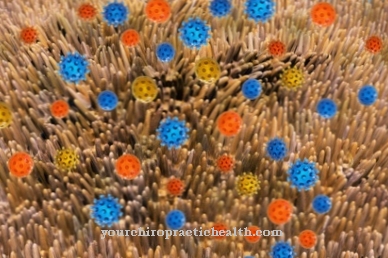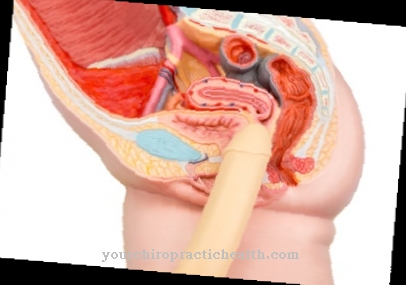The Lock and key principle describes a system of complementary structures that interlock like a key in a lock and trigger certain body processes with this complex formation. The principle is also called Hand-in-glove principle or Induced-fit concept denotes and plays a role for all receptor-substrate complexes. The principle is also decisive for pathological processes such as infections with viruses.
What is the lock and key principle?

With its structures, a key fits into the associated lock with extreme accuracy. As soon as a prong has broken off, the door no longer opens. In this context, we are also talking about accuracy of fit. Just as the key fits in the lock, many biological messengers fit exactly on the structures of the receptors intended for them.
The so-called lock-and-key principle of biology relates in a larger context to two or more complementary structures with a spatial fit to one another. This accuracy of fit goes hand in hand with biochemical reactions.
The lock and key principle was first described in 1894 by Emil Fischer, who at the time described a hypothetical binding of enzymes and substrates. In biology and biochemistry, the interactive bond between guest ligand and receptor host results in a complex with a certain bond strength, which is also known as affinity. Instead of the key-lock principle, these relationships are now also referred to as the induced-fit concept or the hand-in-glove principle.
In most cases, guest ligands are only effective in complex formation through certain parts of their overall structure. In this case, their remaining structures are functionally irrelevant for the complex formation and the effects it provokes.
Function & task
The key-lock principle plays a role in biochemistry and biology in completely different contexts. In biochemistry, transmitters and modulators trigger biochemical processes by binding to a receptor, which can be simulated or blocked by medicinal substances or drugs. The lock-and-key principle plays an essential role for such bonds.
In endocrinology, on the other hand, there is an interaction between hormone receptors and individual hormones, which triggers signal chains and re-influences the function of the cell. The key-lock principle is also relevant in this context. The same applies to the field of enzymology, within which enzymes facilitate biochemical reactions.
This process takes place by bringing together biogenic reactants. The enzymes allow two active substances to form a complex according to the lock and key principle. By binding to the substrate, the enzyme undergoes structural changes that increase or enable its effectiveness as a catalyst on certain substrates.
The lock-and-key principle is also relevant in immunology. Within this area, complement structures play together at the border between the antigen-recognizing and antigen-presenting cells. This complex interplay based on the key-lock principle is a prerequisite for specific antigen detection.
In addition, the lock and key principle plays an essential role for cells in cell aggregates such as tissues or organs. These cells are equipped with structures and their complementary counter-structures on the cell surface. This lock-and-lock complementary system enables communication between cells of a tissue and contributes to the structural and functional cohesion.
The immune cells also communicate using the complementary system described. In addition, circulating immune cells rely on special surface structures so that they can get from place to place and find their way back to their starting point.
Sperm move to the egg using a similar principle. The lock and key principle allows them to find glycoproteins on the egg surface, which they allow them to penetrate into the cell. The principle thus plays a decisive role for human reproduction on a larger scale and is relevant to evolutionary biology.
Illnesses & ailments
The lock and key principle is crucial not only for natural body processes, but also for pathological processes in the human or animal body. On the one hand, certain substances in drugs and other substances block individual receptors according to the lock and key principle. For example, morphine switches off the urge to cough because its active ingredients bind precisely to the cells in the nervous system responsible for the urge to cough.
In addition, the substance has a pain-relieving effect in the same way and binds to pain receptors mainly in the cerebral cortex according to the lock and key principle.Due to the bond, pain stimuli are no longer passed on. So although theoretically painful stimuli are still received, they are no longer processed and no longer reach consciousness. Medicine makes use of this principle to treat patients with acute and chronic pain, such as cancer patients.
On the other hand, the blockade of nerve cells according to the lock and key principle can also disrupt or switch off relevant body processes and thus have negative effects on a patient's health.
The lock and key principle is just as pathological in connection with viruses. These organisms have certain complementary structures, which are also known as docking sites. The docking point of a virus enables it to infect the respective host.
The hand-in-glove principle is also of medical relevance within medical diagnostics. Diagnostic methods such as the typing of individual tissues as part of a biopsy, the diagnosis of infections and the DNA detection or the blood group diagnosis are essentially based on detection by means of the principle.
In addition, many metabolic diseases are based on a disorder of the hand-in-glove principle. This applies, for example, to the form of diabetes mellitus, in which there is complete insulin resistance. In the case of insulin resistance, the "hand" insulin no longer fits into the "glove" insulin receptor. The cell receptors no longer respond adequately to the insulin and the absorption of sugar into the individual cells takes place only to an inadequate extent.
In addition to these relationships, the induced-fit concept plays an important role in everyday medical practice, for example for vaccinations, but also for allergies.
























.jpg)



